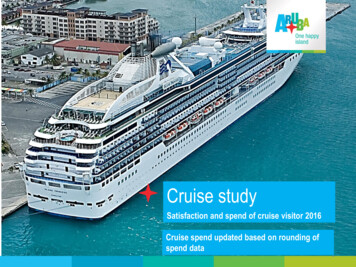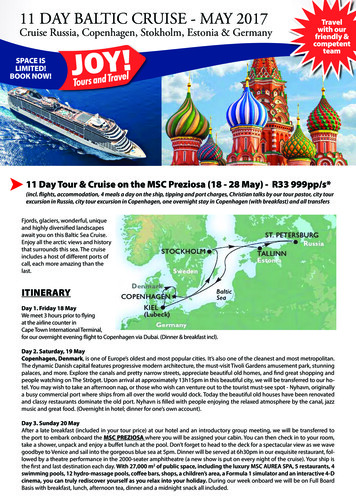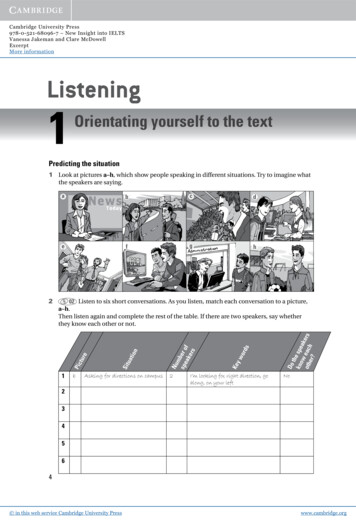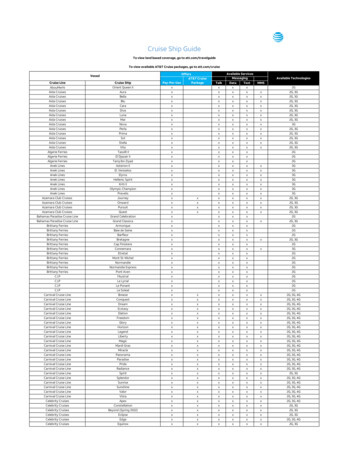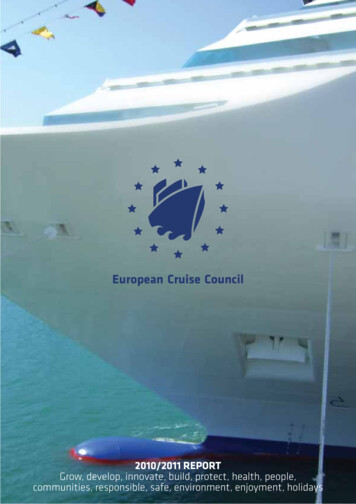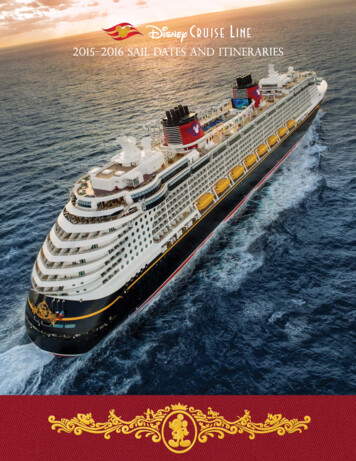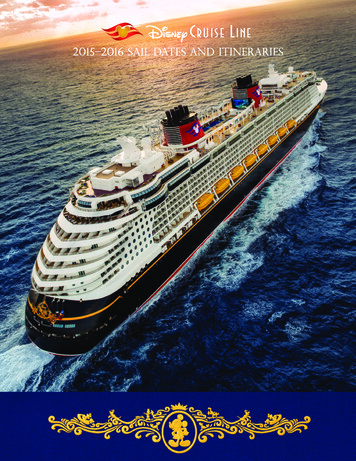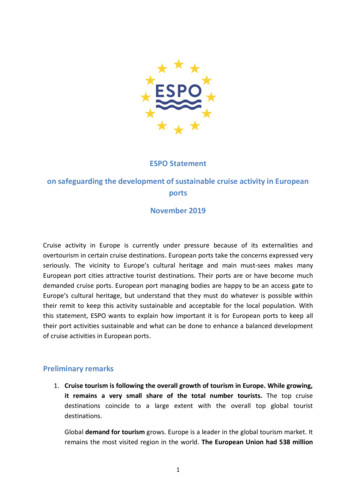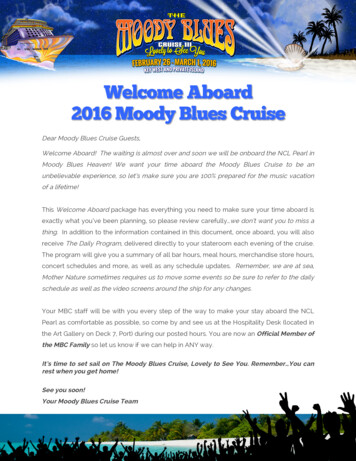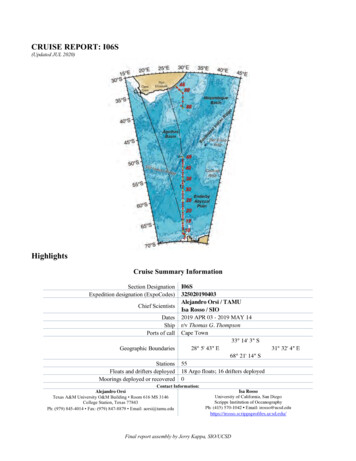
Transcription
!"# %&'"&()"* ' ,-%':7); (;&07 & ?&./012/0134!"# %&'(#))*" ',-./")*0 /-'!"# %&'()"*% ', %&'-./"0% %&'(0"*% ', %&'(1-./&2&0"*324%"5(!#%"' %* *), "*!4%/6&7 *(&5(#,889"& 7,/4%#(:&;'0,7%"*! , %&'* 8&, *(,'0(07%5 "7*(0"/8& "0 &&7%' *(0"/8& "0(&7(7"#&?"7"0I06S325020190403Alejandro Orsi / TAMUIsa Rosso / SIO2019 APR 03 - 2019 MAY 14r/v Thomas G. ThompsonCape Town33 14' 3" S28 5' 43" E68 21' 14" S5518 Argo floats; 16 drifters deployed0!"# %& '(#)"* % ,"#Alejandro Orsi!"# %&'()&* ,-".%,/0&1()&23,45, 6&7&899:&; ;&) & ?;&&@944"6"& / /,9 A&!"# %&BBC? &DEF&GHBHI&C?JK?L ?&7&M #F&GHBHI&C?BKCCBH&7&N: ,4F& 9.%,O/ :3P"53'31 32' 4" EIsa RossoUniversity of California, San DiegoScripps Institution of OceanographyPh: (415) 570-1042 Email: .edu/!"# %&'()*' & ,,(-.%/&./&0(''/&1 )) 2&34567839
Cruise Report of the 2019 I06 USGO-SHIP ReoccupationRelease Draft 1Alejandro OrsiJun 04, 2019
TABLE OF CONTENTS1GO-SHIP I06 2019 Hydrographic Program1.1 Cruise Scientific Objectives . . . . . . . . . . . . . . . . . . . . . . . . . . . . . . . . . . . . . . .1.2 Programs and Principal Investigators . . . . . . . . . . . . . . . . . . . . . . . . . . . . . . . . . .1.3 Science Team and Responsibilities . . . . . . . . . . . . . . . . . . . . . . . . . . . . . . . . . . .12342Cruise Narrative2.1 Main Result . . . . . . . . . . . . . . . . . . . . . . . . . . . . . . . . . . . . . . . . . . . . . . .2.2 Summary . . . . . . . . . . . . . . . . . . . . . . . . . . . . . . . . . . . . . . . . . . . . . . . . .5993CTD and Rosette Setup3.1 Underwater Sampling Package . . . . . .3.2 Winch and Deployment . . . . . . . . .3.3 Maintenance and Calibrations . . . . . .3.4 Logs . . . . . . . . . . . . . . . . . . .3.5 Major Problems (Triage, Care, Analysis):3.6 Cruise Lessons . . . . . . . . . . . . . .11111218182326CTDO and Hydrographic Analysis4.1 CTDO and Bottle Data Acquisition4.2 CTDO Data Processing . . . . . .4.3 Sensor Problems . . . . . . . . . .4.4 Pressure Analysis . . . . . . . . . .4.5 Temperature Analysis . . . . . . .4.6 Conductivity Analysis . . . . . . .4.7 CTD Dissolved Oxygen . . . . . .29293030303444605Salinity5.1 Equipment and Techniques . . . . . . . . . . . . . . . . . . . . . . . . . . . . . . . . . . . . . . . .5.2 Sampling and Data Processing . . . . . . . . . . . . . . . . . . . . . . . . . . . . . . . . . . . . . .5.3 Narrative . . . . . . . . . . . . . . . . . . . . . . . . . . . . . . . . . . . . . . . . . . . . . . . . .656565666Nutrients6.1 Summary of Analysis . . . . . . . .6.2 Equipment and Techniques . . . . . .6.3 Nitrate/Nitrite Analysis . . . . . . .6.4 Phosphate Analysis . . . . . . . . . .6.5 Silicate Analysis . . . . . . . . . . .6.6 Sampling . . . . . . . . . . . . . . .6.7 Data Collection and Processing . . .6.8 Standards and Glassware Calibration6.9 Quality Control . . . . . . . . . . . .676767676868696969704.i
7896.10 Analytical Problems . . . . . . . . . . . . . . . . . . . . . . . . . . . . . . . . . . . . . . . . . . .70Oxygen Analysis7.1 Equipment and Techniques . .7.2 Sampling and Data Processing7.3 Volumetric Calibration . . . .7.4 Standards . . . . . . . . . . .7.5 Narrative . . . . . . . . . . .717171727272Total Alkalinity8.1 Total Alkalinity . . . . . . . . . . . .8.2 Total Alkalinity Measurement System8.3 Sample Collection . . . . . . . . . .8.4 Problems and Troubleshooting . . . .8.5 Quality Control . . . . . . . . . . . .737373747474Dissolved Inorganic Carbon (DIC)9.1 Sample collection . . . . . . . . . .9.2 Equipment . . . . . . . . . . . . . .9.3 DIC Analysis . . . . . . . . . . . . .9.4 DIC Calculation . . . . . . . . . . .9.5 Calibration, Accuracy, and Precision9.6 Underway DIC Samples . . . . . . .9.7 Summary . . . . . . . . . . . . . . .7777777778787979.8181818182828210 Discrete pH Analyses (Total Scale)10.1 Sampling . . . . . . . . . . .10.2 Analysis . . . . . . . . . . .10.3 Reagents . . . . . . . . . . .10.4 Data Processing . . . . . . .10.5 Problems and Troubleshooting10.6 Standardization/Results . . .11 CFC-11, CFC-12, CFC-113, and SF68512 Dissolved Organic Carbon, Total Organic Carbon, Dissolved Nitrogen and Total Nitrogen12.1 Project Goals . . . . . . . . . . . . . . . . . . . . . . . . . . . . . . . . . . . . . . . .12.2 Sampling . . . . . . . . . . . . . . . . . . . . . . . . . . . . . . . . . . . . . . . . . .12.3 Standard Operating Procedure for DOC Analyses- Hansell Lab UM . . . . . . . . . . .12.4 DOC calculation . . . . . . . . . . . . . . . . . . . . . . . . . . . . . . . . . . . . . .12.5 Standard Operating Procedure for TN/TDN analyses- Hansell Lab UM . . . . . . . . .12.6 TDN calculation . . . . . . . . . . . . . . . . . . . . . . . . . . . . . . . . . . . . . .8787878888888913 Carbon Isotopes in seawater (14/13C)9114 LADCP14.1 LADCP system configuration . . . . . . . . . . . . . . . . . . . . . . . . . . . . . . . . . . . . . .14.2 Problems/Setup changes . . . . . . . . . . . . . . . . . . . . . . . . . . . . . . . . . . . . . . . . .14.3 Data Processing and Quality Control . . . . . . . . . . . . . . . . . . . . . . . . . . . . . . . . . .9393949615 Underwater Vision Profiler 5 HD (UVP)15.1 System Configuration and Sampling15.2 Figures . . . . . . . . . . . . . . .15.3 Problems . . . . . . . . . . . . . .15.4 Reference . . . . . . . . . . . . . .ii.99. 99. 99. 99. 105
16 Chipods10716.1 Overview . . . . . . . . . . . . . . . . . . . . . . . . . . . . . . . . . . . . . . . . . . . . . . . . . 10716.2 System Configuration and Sampling . . . . . . . . . . . . . . . . . . . . . . . . . . . . . . . . . . . 10716.3 Data . . . . . . . . . . . . . . . . . . . . . . . . . . . . . . . . . . . . . . . . . . . . . . . . . . . . 11017 Underway pCO211118 Float Deployments11518.1 SOCCOM floats . . . . . . . . . . . . . . . . . . . . . . . . . . . . . . . . . . . . . . . . . . . . . 11518.2 CSIRO floats . . . . . . . . . . . . . . . . . . . . . . . . . . . . . . . . . . . . . . . . . . . . . . . 11718.3 NOAA/PMEL floats . . . . . . . . . . . . . . . . . . . . . . . . . . . . . . . . . . . . . . . . . . . 11919 𝛿18O12119.1 Equipment and Techniques . . . . . . . . . . . . . . . . . . . . . . . . . . . . . . . . . . . . . . . . 12120 Drifter Deployments12321 Glider Deployments12521.1 Preparation . . . . . . . . . . . . . . . . . . . . . . . . . . . . . . . . . . . . . . . . . . . . . . . . 12621.2 Deployments . . . . . . . . . . . . . . . . . . . . . . . . . . . . . . . . . . . . . . . . . . . . . . . 12822 Student Statements22.1 Daniela Faggiani Dias22.2 Maximilian Kotz . . .22.3 Michael Kovatch . . .22.4 Loicka Baille . . . . .133133134134134A Abbreviations137B Bottle Quality Comments139C Calibration Documents147Bibliography167Index171CCHDO Data Processing Notesiii
iv
CHAPTERONEGO-SHIP I06 2019 HYDROGRAPHIC PROGRAMFig. 1: Cruise track and CTD station locations (red dots) during GO-SHIP I6S 2019. White triangles, circles andsquares indicate deployment locations of ARGO and SOCCOM floats and surface drifters.1
Cruise Report of the 2019 I06 US GO-SHIP Reoccupation, Release Draft 11.1 Cruise Scientific ObjectivesAlejandro OrsiComplex oceanic responses to climate change are poorly characterized due to a general lack of repeat high-qualityshipboard measurements of climate-relevant ocean properties. GO-SHIP repeat transoceanic surveys (www.goship.org) provide full water column hydrographic observations with temporal and spatial resolutions adequate to resolve decadal variability in oceanic storage of heat, freshwater, carbon, oxygen, nutrients and transient tracers. Repeathydrographic physical-biogeochemical measurements along 30 E in the southern Indian Ocean enables scientists tobetter tackle important unresolved aspects of Southern Ocean adjustment to atmospheric global warming. The U.S.GO-SHIP I6S 2019 hydrographic section revisited this intercontinental line after its first occupation in 2008, itself a repeat of the original 1996 WOCE transect by France. Temperature, salinity, and velocity measurements from I6S 2019reveal how the heat content of deep and bottom waters in the Enderby Basin have changed while their parent watersover the Antarctic continental shelves have not, but freshened instead. I6S 2019 measurements of oxygen, nutrients,tracers, and dissolved inorganic carbon allow quantifying the anthropogenic component in the total inventory changesof surface and deep waters. Combined carbon and current measurements from the repeat I6S line are used to determine rates of regional carbon accumulation and exchange with adjacent circulations. The overarching achievementof GO-SHIP I6S 2019 measurements was the reoccupation of 55 full-depth CTD stations and the collection of watersamples at different levels with 36 Niskin bottles. Measured temperature, salinity, pressure, oxygen, fluorometry, shearand micro-scale temperature, and the major nutrients, oxygen, salinity, CFC and carbon components were discretelyanalyzed on board. Argo and SOCCOM floats and surface drifter deployments were usually carried out after leavingCTD stations or during slow transits.2Chapter 1. GO-SHIP I06 2019 Hydrographic Program
Cruise Report of the 2019 I06 US GO-SHIP Reoccupation, Release Draft 11.2 Programs and Principal InvestigatorsProgramCTDO Data, Salinity, Nutrients, Dissolved O2Total CO2 (DIC)AffiliationUCSD, SIOPrincipal InvestigatorSusan Becker, Jim SwiftAOML,PMEL,NOAAPMEL, NOAADana Greely,ninkhofDana GreelyUCSD, SIOUHLDEOUTRSMASWHOI, PrincetonAndrew DicksonEric FiringAndreas ThurnherrDong-Ha MinDennis HansellAnn McNichol, Robert KeyTransmissometryFluorescence and Backscatter (SOCCOM)Chipodd18OCSIRO Argo FloatsNOAA/PMEL Argo FloatsSOCCOM FloatsTAMUU MaineWilf GardnerEmmanuel CSIROPMEL, NOAAUW, UCSD, SIOSurface DriftersGPS data/bathymetryUVPGlidersNOAA, AOMLUCSDU Alaska FairbanksCaltechJonathan NashMike MeredithRebecca CowleyNOAA/PMELSteve Riser, Ken Johnson,Lynne TalleyShaun DolkDavid SandwellAndrew McDonnellAndrew ewt@caltech.eduUnderwayTemperature,Salinity, and pCO2Total Alkalinity, pHSADCPLADCPCFCs, SF6, N20DOC, TDN, TOC, TNC13 & C141.2. Programs and Principal InvestigatorsRik oaa.gov3
Cruise Report of the 2019 I06 US GO-SHIP Reoccupation, Release Draft 11.3 Science Team and ResponsibilitiesDutyChief ScientistCo-Chief Scientist, floatsand driftersCTD Watchstander, GlidersCTD Watchstander, GlidersCTD Watchstander, ChipodsCTD Watchstander, ChipodsCTD WatchstanderCTD WatchstanderCTD Watchstander, LADCPNutrients, ODF supervisor,SOCCOM floatsNutrients, Database SupportCTDO ProcessingSalts, ET, CTD/RosetteMaintenanceSalts, CTD/Rosette MaintenanceDissolved O2 , DatabaseManagementDissolved O2UVPDIC, underway pCO2DICCFCs, SF6CFCs, SF6CFCs, SF6 studentTotal AlkalinityTotal AlkalinitypHDOC, TDN, Radio CarbonIndep/NurseMarine Technician, LeadMarine Technician4NameAlejandro OrsiIsabella RossoAffiliationTAMUUCSDEmail Addressaorsi@tamu.eduirosso@ucsd.eduGiuliana ViglioneMaximilian KotzMichael KovatchDaniela Faggiani-DiasLoicka BailleKay McMonigalBenjamin MusciSusan BeckerCaltechCaltechUCSDUCSDTAMUU MiamiGeorgia TechUCSD er@ucsd.eduMelissa MillerKenneth JacksonJohn CalderwoodUCSD ODFUCSD ODFUCSD .eduJoseph GumUCSD ODFjgum@ucsd.eduAndrew BarnaUCSD ODFabarna@ucsd.eduZachary AndersonJessica PrettyAndrew CollinsPatrick MearsDavid CooperMark LopezGarrett WalshManuel BelmonteWiley WolfeKayleen FultonChelsi LopezRachel CampbellJen NomuraCroy CarlinBermuda Institute of Ocean ScienceU ALASKAUWU MiamiUTUTTAMUUCSDUCSDUCSDU avidcooper59@gmail.commalopez iami.edun/ajnomura@uw.educroyc@uw.eduChapter 1. GO-SHIP I06 2019 Hydrographic Program
CHAPTERTWOCRUISE NARRATIVEAlejandro OrsiBefore starting our journey South the entire team safely made it to Cape Town, where for a few balmy days we savoredthe majestic scenery of Table Mountain, the region’s vibrant music and its culinary delights. Waiting for us docked atberth A was our ship, the research vessel Thomas G. Thompson. We were greeted by the Captain and an impressivecrew eager to facilitate our smooth transition to living and working on the ship. A couple of days before departure theThompson was refueled and fully loaded with palettes of fresh goods to keep everybody well- nourished during thenext 40 days (or so). Since no science party had to move out of the ship, we were able to board and begin loadingright away the numerous pieces of equipment from our different groups. The ODF container arrived early on, as didthe DIC van later secured on the back deck, whereas ODF’s was transferred to the forward 02 deck. Just watchingeverybody work together so efficiently during the set-up days gave the privileged assurance of having an excellentteam to face the likely upcoming challenges on this cruise. Most impressive is the overall collegiate, respectful andfriendly atmosphere surrounding the Thompson since we started our journey.A blessing in disguise, perhaps, resulted in a delayed departure by a few hours. Before setting sail around 4 PM onApril 3, 2019 a scorching smell emanated from loose light bulbs in a switchboard panel; it had to be repaired withthe help of a local electrician. We then enjoyed the magnificent, albeit brief, sailing experience of leaving the cityand the Cape of Good Hope behind us, in a sunny afternoon of calm seas. But the test to our seaworthiness came upearlier than expected. Rough seas and strong gusty winds took a heavy toll on our progress to the south. Rolls duringthe storm left one of the main engines inoperable. After almost 26 hours of transit the Captain and I decided to turnaround and pursue the purchasing of replacement parts. We were back to an area off Cape Town late in the afternoonof April 6. The needed pump was not available in South Africa. One was purchased from Caterpillar and scheduledto be hand-carried from Seattle to Cape Town. Meanwhile Meegan Corcoran, our benefactress Port Captain on herway back to the U.S., managed to locate, purchase and FedEx another spare part during a layover in Amsterdam! Anarrival date for either of these parts was unknown, considering ongoing strikes in South Africa. We could only wait.But we also took advantage of the temporary impasse to conduct our test cast, originally planned to take place at alocation farther to the south. With some minor hiccups for which we had plenty of time to iron out, all instruments anddata acquisition protocols were successfully tested. Then we could only wait, and wait more, for the engine’s parts.Fortunately, both items cleared customs and were available to our agent at about the same time. They were deliveredto the boat around 8 PM on April 8, 2019.With the affected engine fixed while underway, and a spare part in stock, we were ready to face our second southwardcrossing of the Agulhas Current Retroflection. This time Mother Nature was more merciful, allowing us to steamat an average speed of 12.5 knots. Against all odds, favorable cruising conditions prevailed for another 8 days, andcounting! We crossed the Antarctic Circle paying due respect to king Neptune and celebrating the new Red Nosesaboard. Shortly after, in the morning of April 16, we woke up to a smooth sea covered with grease ice, that rapidlyturned into a patchy field of small-sized pancake ice. The Thompson’s Captain and Mates very skillfully navigatedtowards the target 536-m isobath off Riiser Land near 31 E. At one point, still at water depths of about 700 m, wehesitated about continuing straight further south because patches of older sea ice ahead of us were moving fast to thesouthwest. Again, we were fortunate to find a long lead oriented almost across the local isobaths and only a little offthe intended track. We followed it slowly at 2 knots for about two hours and stopped over the 530-m isobath to occupyour first station.5
Cruise Report of the 2019 I06 US GO-SHIP Reoccupation, Release Draft 1All things considered, our petition of compensatory ship time loss (5 days) due to engine problems was followed byan empathetic 2-day extension of our cruise. This is entirely the result of the prompt intervention and collaborationbetween University of Washington, GO-SHIP Program and National Science Foundation managers. In addition, ourswift steam to the Antarctic shelf resulted in about 1-day gain. Therefore, with Station 1 we started I06S measurementsat 8:47 UCT on April 16, 2019 with a net ship time deficit of about two days.A punishing sampling pace was kept, as expected, along the planned short (39 nm) northwestward segment of nineclosely-spaced stations (1 nm to 10 nm) across the Antarctic slope. These extenuating circumstances resulted in thegeneral backlog of different samples, to be processed at a later time during the longer transits between stations 30 nmapart. Less than 24 hours after starting Station 1, we completed station 9 at a water depth of 3776 m and changedcourse to continue due north along 30 E.By April 20 we had already surveyed the southernmost 330 nm of the long (1,980 nm) meridional segment of I06S,occupying 10 more stations in about 41 hours. In addition, our trained students have also assisted in the overboarddeployment of two surface drifters, four ARGO floats and two SOCCOM floats. We have been occasionally visited byhumpback whales and Antarctic petrels, as well as cruised by large distant icebergs and enjoyed spectacular views ofAurora Borealis, sunsets, and bioluminescence. Eerie or not, weather and seas have been extremely sympathetic to ussince we left Cape Town for the second time.On April 30 the successful 4-hr deployment of one glider was carried out from a zodiac, with the joyful assistanceand training of a graduate student and the Co-Chief Scientist. A second glider was more spectacularly launched withthe Thompson’s crane. Trained students assisted in the overboard deployment of more surface drifters, ARGO andSOCCOM floats. By May 1, in one way or another, we had worked progressively along the main I6S meridional line.However, we had also been halted extensively, and forced to prematurely terminate the first cast of Sta. 44, waiting forthe recommended working conditions of swells smaller than 3-5 m – atypical in the Southern Ocean. Almost 3 fulldays (25-28 April) of work were lost to bad weather during the passage of a large cyclone.During workable periods of time we managed to maintain a commendable pace. A total of 27 stations (Sta. 16-43)were occupied in the Enderby Abyssal Plain, all located at water depths greater than 5000 m, at an average time of 3.9hours per station. All of the 30-nm transits between stations were done at ship speeds exceeding 11 knots.A 51.6-hr delay in CTD work between April 30 and May 2 was caused by another large storm. We managed to occupyStas. 44 and 45 before the next mega storm got in our way, this timewe valiantly battled it for 42.7 hours during May6Chapter 2. Cruise Narrative
Cruise Report of the 2019 I06 US GO-SHIP Reoccupation, Release Draft 1Fig. 1: Dodging attempt as a large low-pressure passed through our cruise track during 25-27 April. The final sciencedelay was of about three full days.Fig. 2: A relatively weaker storm interrupts science work on May 1st, for 1.15 days.7
Cruise Report of the 2019 I06 US GO-SHIP Reoccupation, Release Draft 12-4. Combining these last two bad weather- related delays to those suffered in April 24 (9.8 hours), April 25-28 (71.6hours), plus 7 hours here and there, it adds up to 7.6 days or 18.7% of the cruise duration.The most unfortunate event in our cruise was the medical evacuation of a graduate student, while we were coping astorm on May 4 near 30 E, 50 S. The rapid transit to Port Elizabeth (yet 10.7% of the cruise duration) resulted in thesuccessful evacuation and provision of appropriate health care to the student in land. Nonetheless, the 4.3-day transitback to the planned location of Sta. 46 could not be accomplished in the amount of time left.About 130 nm northeast of Port Elizabeth we occupied a relocated Sta. 46 at water depth of about 550 m. Stations 47to 51 (30 E, 35 S) were located farther to the southeast with progressively larger spacing in between (10 to 35 nm).The last four stations were intended to be 1 latitude reoccupations along 30 E, but interference from a chines fishingvessel resulted in the slight relocation of Sta. 54. Strict implementation of the 23:00 May 11 deadline to our brief andfinal 69 hours of work time placed Sta. 55 at 30 E, 38.5 S. Near 23:00 local on May 11, 2019 we had finished Sta. 55at 30 E, 38.5 S, ending the sixth calendar week since departing Cape Town at 16:00 local on April 3, 2019.All in all, accounting for the time spent on transit between and at stations, the total of work time was 14.8 days, only36.3% of the 40.7-day cruise. Our expert and relentless teams of hard- working scientists defied punishing weather,mechanical and medical failures to accomplish, on average four deep CTD stations per work day.Fig. 3: GO-SHIP I6S 2019 cruise timeline.8Chapter 2. Cruise Narrative
Cruise Report of the 2019 I06 US GO-SHIP Reoccupation, Release Draft 12.1 Main Result2019 occupation of the GO-SHIP I6S Hydrographic Section: overall accomplishment of the original hydrographicplan was around 60%, or 55 out of 91 CTD stations.How did this happen? Unfavorable seas, sea-ice and weather are all well-known and unavoidable conditions thatmake working in the Southern Ocean so uniquely unpredictable. The sole remoteness of the I6S line required longsteaming times: 7.5 days to the first station, and 2.4 days from the last station to Cape Town. That is, 24.3% of thecruise time was spent on steaming back and for to do CTD work.Engine problems resulted in the loss of 5.1 days, but they happened at the very beginning of our cruise, and it waspartially ameliorated with two additional days.What ifs? It’s understandable that sometimes we contemplate alternative scenarios to less than desirable story endings.Consider, for instance, how efficient our science teams performed throughout the working time on this cruise. At theestablished working pace and 30-nm spacing a happy ending would have needed:a) 6.3 more work days to fill in the 11.5 gap now left unsampled along 30 E; orb) only 1.3 days of bad weather out of 41 days in the Southern Ocean; orc) a more reasonable 3.3 bad weather days and no engine failures; or,d) even with all the experienced bad weather but sparing preventable mechanical and health failures.It is hoped that, in addition to acquiring new hydrographic measurements with the highest quality standards, our I6S2019 experience will also better prepare the next generations for the many challenges of working in the SouthernOcean.2.2 SummaryThe quality of the data collected is very high, particularly from the chemistry teams who have delivered an excellentand very high-resolution data set. We are confident that this occupation of I6S has uncovered clear and ongoingchanges in the deep ocean heat and carbon content, and chemistry. The mixing information taken via the shearmeasured by the LADCP, sADCP and fine and microscale properties via the chi-pods and CTD will also be veryinsightful and unprecedented along this line.2.1. Main Result9
Cruise Report of the 2019 I06 US GO-SHIP Reoccupation, Release Draft 110Chapter 2. Cruise Narrative
CHAPTERTHREECTD AND ROSETTE SETUPFor I06S-2019 the new STS 36 place yellow rosette and bottles, built in 2017, were used. These rosette and bottleswas built before P06 2017, making this the third time this package has been deployed. The bottles were made withnew PVC, with new non-baked o-rings and electro-polished steel springs. This represents a change from the past,where on GO-SHIP cruises using ODF equipment before P06 2017 o-rings were baked for 3 days at 100 C at 1-3Torr in a sweeper gas of hydrogen. Springs used to be painted and Tygon tubing added to the ends to prevent paintwearing away from bottle firing. As on P06 2017 no sample contamination has been noticed by the change in o-ringsand springs. The package used on I06S-2019 weighs roughly 1500 lbs in air without water, and 2350 lbs in air withwater. The package used on I06S-2019 weighs roughly 950 lbs in water. In addition to the standard CTDO packageon GO-SHIP cruises three chipods, two LADCPs, and one UVP were mounted on the rosette. During the cruise weencountered numerous problems, most notably modulo errors through the cruise resulting in multiple re-terminations.We describe all of the above in more detail in the sections below.3.1 Underwater Sampling PackageCTDO/rosette/LADCP/chipod casts were performed with a package consisting of a 36 bottle rosette frame, a 36-placecarousel and 36 Bullister style Niskin bottles with an absolute volume of 10.6L. Underwater electronic componentsprimarily consisted of a SeaBird Electronics housing unit with Paroscientific pressure sensor with dual plumbed lineswhere each line has a pump, temperature sensor, conductivity sensor, and exhaust line. A SeaBird Electronics membrane oxygen sensor was mounted on the “primary” line. A reference thermometer, transmissometer, chlorophyll-afluorometer and backscatter meter, and altimeter were also mounted on the rosette. Chipod, LADCP, and UVP instruments were deployed with the CTD/rosette package and their use is outlined in sections of this document specific totheir titled analysis.CTD and cage were horizontally mounted at the bottom of the rosette frame, located below the carousel for all stations.The temperature, conductivity, dissolved oxygen, respective pumps and exhaust tubing was mounted to the CTD andcage housing as recommended by SBE. The reference temperature sensor was mounted between the primary andsecondary temperature sensors at the same level as the intake tubes for the exhaust lines. The transmissometer wasmounted horizontally on the lower LADCP brace with hose clamps around both of its ends, avoiding shiny metalor black tape inside that would introduce noise in the signal. The fluorometer and backscatter meter and altimeterswere mounted vertically inside the bottom ring of the rosette frames, with nothing obstructing their line of sight. The150 KHz bi-directional Broadband LADCP (RDI) unit was mounted vertically on the bottom side of the frame. The150 Khz LADCP was later replaced with a 300 Khz LADCP during the cruise in the same position. The 300 KHzbi-directional Broadband LADCP (RDI) unit was mounted vertically on the top side of the frame. The LADCP batterypack was also mounted on the bottom of the frame. The LADCP and LADCP battery pack were mounted next to eachother at the beginning of the cruise. If we imagine the LADCP being north on the rosette, the LADCP battery wasmounted east, the CTD mounted west, and the UVP mounted south.11
Cruise Report of the 2019 I06 US GO-SHIP Reoccupation, Release Draft 1EquipmentRosetteCTDCTDCTDPressure SensorPressure SensorPressure SensorPrimary TemperaturePrimary ConductivityPrimary ConductivityPrimary ConductivityPrimary PumpPrimary PumpSecondary TemperatureSecondary ConductivitySecondary PumpTransmissometerTransmissometerFluorometer Chlorophyll and BackscatterPrimary Dissol
Cruise Report of the 2019 I06 US GO-SHIP Reoccupation, Release Draft 1 1.2 Programs and Principal Investigators Program Affiliation Principal Investigator Email CTDO Data, Salinity, Nutri-ents, Dissolved O 2 UCSD, SIO Susan Becker, Jim Swift sbecker@ucsd.edu, jswift@ucsd.edu Total CO 2 (DIC) AOML, PMEL, NOAA Dana Greely, Rik Wan-ninkhof dana .


